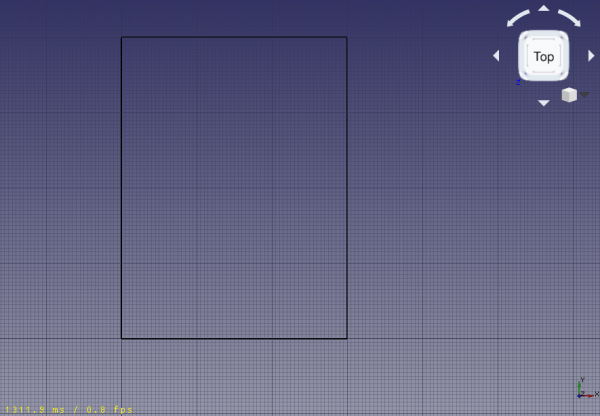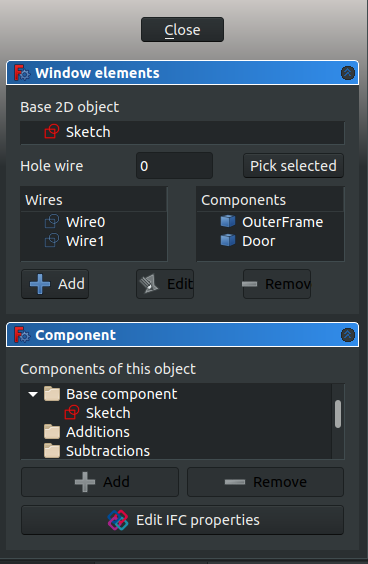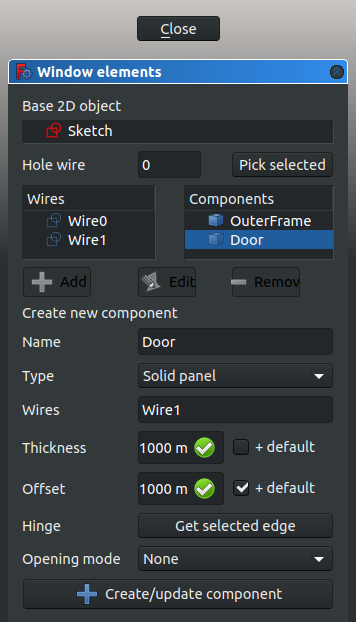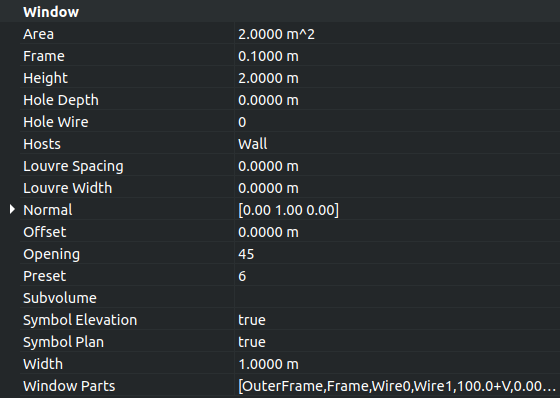Tutorial for open windows: Difference between revisions
(→Opening the doors: Images) |
|||
| Line 72: | Line 72: | ||
:11.4. Change the <code>Opening mode</code> to '''{{KEY|Arc 90}}''', or any other option. |
:11.4. Change the <code>Opening mode</code> to '''{{KEY|Arc 90}}''', or any other option. |
||
:11.5. Click the '''{{KEY|+Create/update component}}''' button, and then '''{{KEY|Close}}''' to finish editing the door. The Sketch may become hidden again. |
:11.5. Click the '''{{KEY|+Create/update component}}''' button, and then '''{{KEY|Close}}''' to finish editing the door. The Sketch may become hidden again. |
||
[[Image:05_T01_window_edit.png|600px|Dialog to edit windows and doors]] |
|||
[[Image:06_T01_window_edit_component.png|600px|Dialog to edit the components that make the window or doors]] |
|||
12. Select <code>Door</code>, and give the property {{PropertyData|Opening}} a value of 45. The solid panel of the door should open to the inside of the building. |
12. Select <code>Door</code>, and give the property {{PropertyData|Opening}} a value of 45. The solid panel of the door should open to the inside of the building. |
||
| Line 78: | Line 82: | ||
14. Repeat the steps with <code>Door001</code> and the underlying <code>Sketch002</code> to make the door open 75 degrees to the inside of the building. Also show the elevation and plan symbols. |
14. Repeat the steps with <code>Door001</code> and the underlying <code>Sketch002</code> to make the door open 75 degrees to the inside of the building. Also show the elevation and plan symbols. |
||
[[Image:07_T01_window_property_view.png|600px|Property view to change Opening, Symbol elevation, Symbol plan]] |
|||
== Opening the windows == |
== Opening the windows == |
||
Revision as of 23:36, 27 October 2018
In progress
This tutorial uses FreeCAD 0.18.
This tutorial shows how to have Arch Windows and Doors open in the 3D model, and to indicate this in a 2D drawing (plan and elevation projection). It uses the Draft Workbench, the Arch Workbench, and the TechDraw Workbench.
Setup
1. Open FreeCAD, create a new empty document, and switch to the Arch Workbench.
2. Make sure your units are set correctly, Edit → Preferences ... → General → Units. For example, MKS (m/kg/s/degree) is good for dealing with distances in a typical building; moreover, setting 4 decimals is good to consider even the smallest fractions of a meter.
3. Use the Draft ToggleGrid button to show a grid with enough resolution. You can change the grid properties if needed, Edit → Preferences ... → Draft → Grid and snapping → Grid. For example, lines at every 50 mm, with major lines every 20 lines, and 1000 lines in total.
4. Zoom out of the 3D view if you are too close to the grid.
Create a simple building with closed walls, two doors and two windows.
Placing a wall
5. Use the Draft Wire tool to create a closed wire. Go counterclockwise.
- 5.1. First point in (0, 0, 0); in the dialog enter 0 m ENTER, 0 m ENTER, 0 m ENTER
- 5.2. Second point in (3, 0, 0). Press x to constrain the movement to the X axis; enter the value 3 m ENTER
- 5.3. Third point in (3, 4, 0). Press y to constrain the movement to the Y axis; enter the value 4 m ENTER
- 5.4. Fourth point in (0, 4, 0). Press x to constrain the movement to the X axis; enter the value - 3 m ENTER
- 5.5. Press o to close the Wire, and close the tool.
- 5.6. In the number pad press 0 to get an axonometric view of the model.
- Note: the points can also be defined with the mouse pointer by choosing intersections on the grid, with the help of the Draft Snap toolbar and the Draft Grid method.
6. Select the DWire and change the property DataMake Face to false
7. Select the DWire and click the Arch Wall tool; the Wall is immediately created with a default width (thickness) of 0.2 m, and height of 3 m.
- Note: if the property DataMake Face of the
DWireistrue, this step would create a solid block, instead of using only the contour of theDWire.
Placing doors and windows
8. Click the Arch Window tool; as preset select Simple door, and change the height to 2 m
- 8.1. Change the snapping to Draft Midpoint, and try selecting the lower edge of the frontal wall; when the midpoint is active, click to place the door.
- 8.2. Click the Arch Window tool again, and place another door, but this time in the midpoint of the back wall; rotate the standard view if necessary.
9. Click the Arch Window tool; as preset select Open 1-pane, and change the Still height to 1 m
- 9.1. Keep the snapping to Draft Midpoint, and try selecting the lower edge of the left side wall; when the midpoint is active, click to place the window.
- Note: the
Still heightis the distance from the floor to the lower edge of the element. For doors theStill heightis usually 0 m as doors are normally touching the floor; on the other hand, windows have a usual separation of 0.5 m to 1.5 m from the floor.
- 9.2. Click the Arch Window tool again, and place another window, but this time in the midpoint of the right wall; rotate the standard view if necessary. This time make the window's width (length) 1.5 m, and again make the
Still height1 m
- 9.3. Move the
Window001a bit higher. Select the underlyingSketch004, and change its position to[3.1 m, 2.0 m, 1.6 m]. The entireWindow001should move up. The wall may still show an opening in the previous position; if this happens, right click theWallelement, selectMark to recompute, and then press CTRL+r to recompute the model.
Wall built with doors and windows
Note: when placing a window or a door with a preset, hover the element over the Arch Wall, and wait for the element to rotate so that it is parallel to that wall. Use the Draft Near method from the Draft Snap toolbar to easily select a face of the wall; aim for the lower edge of the wall, and use the Still height to adjust the distance from the floor. Having many Draft Snap modes active at the same time may cause issues with placing the element, so try with only one option at a time.
Note 2: if the window or door was placed parallel to the Arch Wall, but not exactly in the position that you want it, you can adjust the position of the underlying Sketcher Sketch from the property view. The Still height parameter can only be used when initially creating the window from a preset. Once the window is placed, modify the placement with the DataPosition vector [x, y, z].
Placing windows on the frontal wall
Placing windows on the side wall
Opening the doors
10. Select Sketch underlying Door, and press SPACE, or change the property ViewVisibility to true
11. Double click Door in the tree view to start editing it.
- 11.1. Inside the
Window elementsframe there are two panes,WiresandComponents. - Note: with a simple door preset there are two wires,
Wire0andWire1, and two components,OuterFrameandDoor. With a custom designed Arch Door, there may be more wires and components. - 11.2. Click on
Door, and click the Edit button. This shows the properties of theDoorcomponent likeName,Type,Wires,Thickness,Offset,Hinge, andOpening mode. - 11.3. In the 3D view, select only one vertical edge in the visible Sketch of the door, then click the Get selected edge button. The button should change to an edge name, for example, Edge8.
- 11.4. Change the
Opening modeto Arc 90, or any other option. - 11.5. Click the +Create/update component button, and then Close to finish editing the door. The Sketch may become hidden again.
12. Select Door, and give the property DataOpening a value of 45. The solid panel of the door should open to the inside of the building.
13. Select Door, and change the property DataSymbol Elevation to true; a wire starting from the door frame should indicate where the door opens; this is easier to see if the viewport is switched to front view. Change the property DataSymbol Plan to true; a circular arc should indicate how the door opens; this is easier to see if viewport is switched to top view.
14. Repeat the steps with Door001 and the underlying Sketch002 to make the door open 75 degrees to the inside of the building. Also show the elevation and plan symbols.
Opening the windows
15. Select Sketch003 underlying Window, and press SPACE, or change the property ViewVisibility to true
16. Double click Window in the tree view to start editing it.
- 16.1. Click on the
InnerFramecomponent, and click the Edit button.
- 16.2. In the 3D view, select only one vertical edge of
Sketch003. The wires representingOuterFrameand theInnerFrameare very close to each other, so zoom in as close as possible to the Sketch to select the appropriate wire. Then click the Get selected edge button. The button should change to an edge name, for example, Edge12. - Note: when there are many solids on the screen that it becomes difficult to select only one edge, switch to wireframe mode to remove the solid objects, and see only the wires, edges, and contours of those solids.
- 16.3. Change the
Opening modetoArc 90 inv, or any other option.
17. Select Window, and give the property DataOpening a value of 45. The inner frame containing the transparent glass should open to the inside of the building.
18. Select Window, and change the property DataSymbol Elevation to true; a wire starting from the window frame should indicate where the inner frame opens; this is easier to see if the viewport is switched to left side view. Change the property DataSymbol Plan to true; a circular arc should indicate how the inner frame opens; this is easier to see if the viewport is switched to top view.
19. Repeat the steps with Window001 and the underlying Sketch004 to make the window open 75 degrees. Also show the elevation and plan symbols. In this case, don't pick a vertical wire of the InnerFrame as hinge, but pick the top horizontal wire. This means that this window will open differently from the other window. The elevation symbol will be better seen from a right side view. The plan symbol will be better seen from the front view; however, since the wall is obstructing the view, you can change its ViewTransaparency to a value such as 85 to see through it; alternatively you can also change its ViewDisplay Mode to Wireframe to show only its edges.
Making a floor plan of the building
20. In the tree view, select all components, the Arch Wall, the two Arch Windows, and the two Arch Doors, then use the Arch SectionPlane tool to create a Section element.
21. Change to the TechDraw Workbench and insert a new page with the TechDraw New Default tool; a new Page object is created, and the view switches to this page. The page inserted is a standard A4 sheet in landscape orientation, with a basic frame around it. Use the TechDraw New Pick tool if you need to create a new page using a particular SVG template.
22. Select Section, and use the TechDraw NewArch tool to create an ArchView object in the page. Most probably the new object won't be visible in the page because it has a very large scale of 1, that is, 1:1. This means that every meter in the 3D view is shown as a meter in the page view; since the page is only 0.297 m x 0.210 m in size, most features are too big to fit in this page at their natural scale.
23. Select this ArchView object, and change the property DataScale to 0.02, which is equivalent to 1:50, a scale suitable for typical buildings, that is, every meter in the 3D view will be shown as 20 mm in the page. The object should appear in the center of the page, and can be moved to a better position on the left side. The two doors should look like they are open, but only the left window looks open. The reason the right window doesn't appear in the projection is that Section is not high enough in the model, so it doesn't cut through this right window.
24. Switch back to the Arch Workbench. In the tree view select all components again, and use the Arch SectionPlane tool to create a second Section001 element.
- 24.1. Select
Section001and change the property DataPosition to[1.5 m, 2.0 m, 1.8 m]. This second plane does cut through all elements. - 24.2. Switch back to the TechDraw Workbench. Select
Section001, use the TechDraw NewArch tool to createArchView001, and set DataScale to 0.02. The new view in the TechDraw page now shows all openings in the Arch Wall produced by the doors and windows.
Note: for the TechDraw ArchView objects it's advisable to set DataAll On to true, so that all elements cut by the plane are visible, regardless of their state in the 3D viewport. The option DataShow Fill can also be set to true to draw a shade on the cut solids.
Making an elevation projection of the building
25. Go back to the Arch Workbench. In the tree view, select all components, the Arch Wall, the two Arch Windows, and the two Arch Doors, then use the Arch SectionPlane tool to create a third Section002 element.
- 25.1. Rotate
Section002, so that it cuts vertically through the building. Change the properties DataAxis to[1, 0, 0], and DataAngle to90 - 25.2. Change the DataPosition to
[1.5 m, -1 m, 1.5 m]
- Note: you can adjust the ViewArrow Size of the planes to 200 mm, to quickly recognize to which side the planes are pointing.
26. Go back to the TechDraw Workbench, and the Page, and use the TechDraw NewArch tool on Section002; remember to adjust the scale to 0.02 (1:50). Change DataRotation to -90 to correct the appearance of the projections. Arrange ArchView002 next to the others in the page. This third projection looks at the building from the front.
Arch Workbench and TechDraw interaction
As of the time of writing this documentation (FreeCAD 0.18, November 2018), the TechDraw Workbench can only display in its pages what the Arch Workbench provides. This means that the appearance of the elements included with the Arch SectionPlane tool, and displayed by the TechDraw NewArch tool, is ultimately controlled by the Arch Workbench. The TechDraw Workbench only has minimal control over how it display those Arch SectionPlane objects. Therefore, bug reports and feature requests, related to displaying Arch elements should be filed to both workbenches.
A closer interaction between the workbenches is planed for future versions of FreeCAD. It is expected that line width, line color, face color, hatch patterns, and other characteristics will be user editable.



